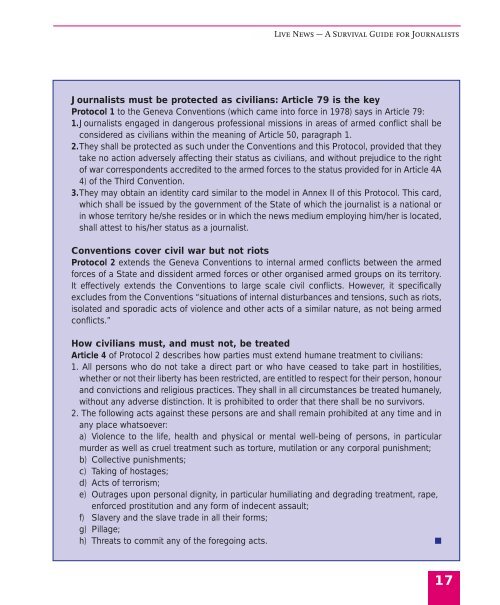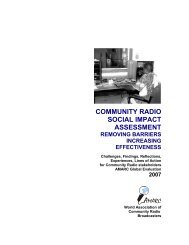Live News - A Survival Guide - International Federation of Journalists
Live News - A Survival Guide - International Federation of Journalists
Live News - A Survival Guide - International Federation of Journalists
- No tags were found...
You also want an ePaper? Increase the reach of your titles
YUMPU automatically turns print PDFs into web optimized ePapers that Google loves.
<strong>Live</strong> <strong>News</strong> — A <strong>Survival</strong> <strong>Guide</strong> for <strong>Journalists</strong><strong>Journalists</strong> must be protected as civilians: Article 79 is the keyProtocol 1 to the Geneva Conventions (which came into force in 1978) says in Article 79:1.<strong>Journalists</strong> engaged in dangerous pr<strong>of</strong>essional missions in areas <strong>of</strong> armed conflict shall beconsidered as civilians within the meaning <strong>of</strong> Article 50, paragraph 1.2.They shall be protected as such under the Conventions and this Protocol, provided that theytake no action adversely affecting their status as civilians, and without prejudice to the right<strong>of</strong> war correspondents accredited to the armed forces to the status provided for in Article 4A4) <strong>of</strong> the Third Convention.3.They may obtain an identity card similar to the model in Annex II <strong>of</strong> this Protocol. This card,which shall be issued by the government <strong>of</strong> the State <strong>of</strong> which the journalist is a national orin whose territory he/she resides or in which the news medium employing him/her is located,shall attest to his/her status as a journalist.Conventions cover civil war but not riotsProtocol 2 extends the Geneva Conventions to internal armed conflicts between the armedforces <strong>of</strong> a State and dissident armed forces or other organised armed groups on its territory.It effectively extends the Conventions to large scale civil conflicts. However, it specificallyexcludes from the Conventions “situations <strong>of</strong> internal disturbances and tensions, such as riots,isolated and sporadic acts <strong>of</strong> violence and other acts <strong>of</strong> a similar nature, as not being armedconflicts.”How civilians must, and must not, be treatedArticle 4 <strong>of</strong> Protocol 2 describes how parties must extend humane treatment to civilians:1. All persons who do not take a direct part or who have ceased to take part in hostilities,whether or not their liberty has been restricted, are entitled to respect for their person, honourand convictions and religious practices. They shall in all circumstances be treated humanely,without any adverse distinction. It is prohibited to order that there shall be no survivors.2. The following acts against these persons are and shall remain prohibited at any time and inany place whatsoever:a) Violence to the life, health and physical or mental well-being <strong>of</strong> persons, in particularmurder as well as cruel treatment such as torture, mutilation or any corporal punishment;b) Collective punishments;c) Taking <strong>of</strong> hostages;d) Acts <strong>of</strong> terrorism;e) Outrages upon personal dignity, in particular humiliating and degrading treatment, rape,enforced prostitution and any form <strong>of</strong> indecent assault;f) Slavery and the slave trade in all their forms;g) Pillage;h) Threats to commit any <strong>of</strong> the foregoing acts. ■17
















